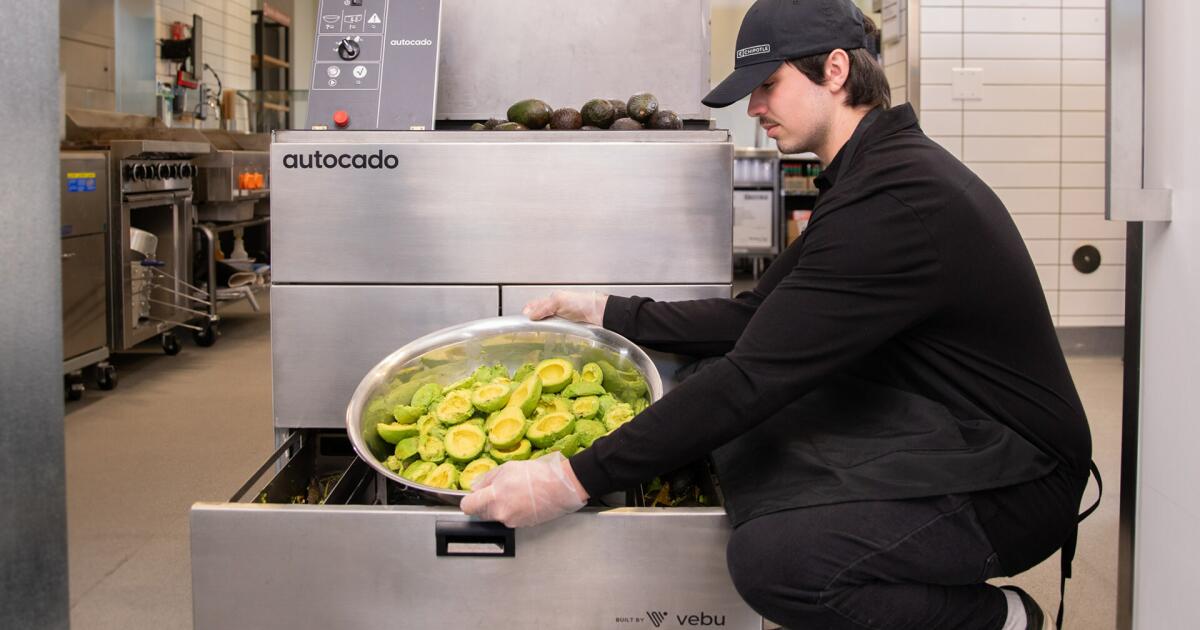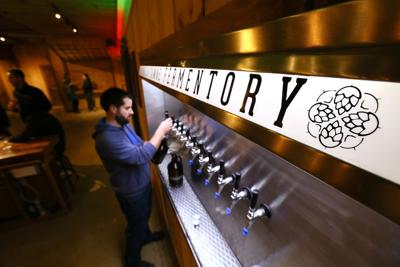
For decades Stir Crazy was a coffee shop, a business squeezed among Melrose Avenue’s endless buildings of connected restaurants and shops and offices interrupted only by cross streets. Dino Trucco took over the place in 1994, tore out the Formica-tile decor from the previous occupant, called Java Man, and installed thick wood panels to surround its neat lines of tables with a log cabin vibe. Then time pretty much stopped inside for 30 years.
Macklin Casnoff grew up in Los Angeles and was a habitué of Stir Crazy. Over the years the espresso served from its counter never really graduated to the third-wave moment. The interior grew scruffy and, as a hangout for generations of writers, clammy from the haze of stray storylines left unfinished or unfulfilled under its roof.

But something about the shop’s size and community value had lodged in Casnoff’s psyche, so much so that he proposed the idea of opening a restaurant there with Mackenzie Hoffman. The two hospitality professionals had been working together through the pandemic at Jill Bernheimer’s wonderful wine shop Domaine L.A.
just up the street. In 2022 they approached Trucco, who decided he was ready to retire. Together with music industry veteran Harley Wertheimer as the third partner, they signed a new lease and set out to transform everything about Stir Crazy but its name.
The result: minimalist space, maximum impact. A warming renovation that serves form and function. A casual, Euro-Californian menu.
An incredible wine program led by Hoffman. In the year since the trio settled in, an old haunt has been reborn with a new soul. Small restaurants occupy a particular psychology in cities, especially in one as infinite as Los Angeles.
I’m not thinking of the buzzy dens that equate cramped and claustrophobic with exclusivity, but the tiny sanctuaries in which we can feel contained, secure. The rooms that shelter our bodies and minds from the big world for a couple of hours. In its new configuration, Stir Crazy’s dining area spans 500 square feet.
The eight tables around its margins, including an eggplant-colored banquette, seat up to 25 people. Square white-oak panels trim the lower half of the walls. Above them hang double sconces with pleated lamp shades and art (sketches, portraits, prints) either properly hung or pinned in place unframed.
What a rundown of details doesn’t convey is the sensory dimensions. There’s a sweetness to the communal bubble here. It speaks to the parts of our brains that loved hunkering down in a tree house, or building a fort with blankets under furniture — only now we’re adults at comfortable tables with smart plates and skin-contact Alsatian Silvaner swirling in our stemware.
Another relaxing element, relative to the restaurant’s kitchen proportions: The menu and by-the-glass lists are concise. Less deliberation, less angst. Food items number around a dozen.
Some could qualify either as opening starters or aperitivo snacks. Start with a round of salty-good Ibérico ham and Parmigiano-Reggiano whacked into hunks, a playful cippolini onion dip with potato chips and a lovely plate of filleted anchovies scattered with hazelnuts and laid over tarragon-forward salsa verde. If you’re eating lightly, you could happily order a repeat cycle of these and be done.
Scan a little further and the choices speak to a certain Angeleno restaurant-loving crowd: the seasonal local ingredients, the friendly mingling of Italian and Japanese and Korean flavors. As summer wound down during a recent dinner, blackberries added juicy tartness to tuna tartare with shaved fennel. Nectarines played so well with brown butter and shiso in a rockfish crudo dish that the fish nearly became superfluous.
Pearls of Sardinian fregola lolled around the palate in satisfying contrast to loamy, basil-scented ratatouille. There was also a pretty, sculptural tangle of pole beans left squeaky crisp and starkly vegetal. I prefer them simmered to tenderness (my Southern roots showing) and ate around the beans to reach cucumbers swiped through lemony-sharp tonnato and grated bottarga.
The kitchen team, led by Caroline Leff (who worked with Hoffman at the short-lived Onda in Santa Monica), keeps a few perennials in rotation. Among them is a celery salad with walnuts, goat cheese and raisins that nicely pings between sweet and savory, soft and crunchy. As a main course, a link of mildly spiced German-style sausage, sourced from Mattern’s Deli in Orange County, is presented with a mound of Japanese-style potato salad creamy from Kewpie mayo and a healthy dollop of mustard.
Both dishes are forthrightly delicious, and the kind of untaxing combinations I could eat once a week. That’s precisely their aim. And to order as a glass alongside: a German pinot blanc, herbal and peachy? A fresh, citrusy trebbiano from Abruzzo? An Austrian zweigelt that pitches cherry right down the middle? Minus dessert wines, the selections usually number less than 10.
It’s enough because the staff asks the right questions about your tastes and is unusually perceptive about recommendations. That’s Hoffman’s department, and she writes one of my favorite wine lists in Los Angeles. Bound pages with never-ending lists of data about producers and years overwhelm or bore most of us.
I look for a way in, something that makes me want to ask questions. Hoffman, for example, adds subtle, intriguing comments in bold about the availability of some bottles: “last call,” “new,” “restock.” Why are these popular, or special, or just now on hand? They’re little primers to give the diner a conversation opener, if they’d like one, and something beyond the standard approach of being asked, “What kind of wine do you like to drink?” Hoffman likens the choice of having 300 bottles on hand in a restaurant this size to mounting her record collection for display.
“I’ve gathered all of these artists — these producers, these farmers — since I started working in restaurants at age 18,” she said in an interview. “It’s another form of storytelling. A winemaker maybe only makes like 30 to 40 vintages.
If I’ve been following someone’s work for 10 years, I’ve seen almost a third of their life’s work, a third of their life’s harvest.” Talk enough with Hoffman and you’ll recognize her mix of wines leans into some of the day’s catchwords — natural, biodynamic, low-intervention. She’ll show up at a table holding two or three bottles to describe styles, glean interest, watch reactions.
She remembers what you like when you return. Which is to say, the restaurant has a growing corps of regulars. We embrace the quirky hours, Monday to Friday.
Parking is torturous enough through the Melrose corridor on the weekdays, plus giving a restaurant staff off on Saturday and Sunday seems boldly civilized. Part of the reward of Stir Crazy’s scale, too, is sensing the tangible mood shifts: quieter and chill early in the week, more bottles and rowdiness later in the week. Maybe one dish will slide into autumn ingredients.
Maybe the obscure white from Switzerland has sold out and you’ll be instead drinking an outside-the-box Chardonnay from the Central Coast with disarming hints of salted almonds. In a place this small, everything feels significant..














